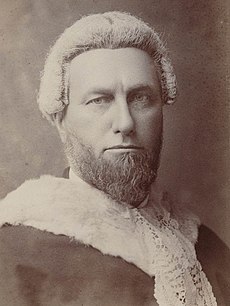Sir William Charles Windeyer | |
|---|---|
 Judge William Charles Windeyer, c. 1890, by Freeman and Co | |
| 6th Chancellor of the University of Sydney | |
| In office 1895–1896 | |
| Preceded by | William Manning |
| Succeeded by | Henry MacLaurin |
| 6th Vice-Chancellor of the University of Sydney | |
| In office 1883–1886 | |
| Preceded by | Robert Allwood |
| Succeeded by | Henry MacLaurin |
| Justice of the Supreme Court of New South Wales | |
| In office August 1881 – 31 August 1896 | |
| 16th Attorney General of New South Wales | |
| In office 22 March 1877 – 16 August 1877 | |
| Preceded by | William Dalley |
| Succeeded by | William Dalley |
| In office 21 December 1878 – 10 August 1879 | |
| Preceded by | William Foster |
| Succeeded by | Robert Wisdom |
| 14th Solicitor General for New South Wales | |
| In office 16 December 1870 – 13 May 1872 | |
| Preceded by | Julian Salomons |
| Succeeded by | Joseph Innes |
| Personal details | |
| Born | 29 September 1834 London, United Kingdom |
| Died | 11 September 1897 (aged 62) Bologna, Italy |
| Spouse(s) | Mary Elizabeth, née Bolton |
| Children | 5 daughters including Margaret; three sons including Richard and William |
| Parent(s) | Richard Windeyer; Maria Camfield |
| Education | The King's School, Sydney |
| Alma mater | University of Sydney |
Sir William Charles Windeyer (29 September 1834 – 11 September 1897) was an Australian politician and judge.
As a New South Wales politician he was responsible for the creation of Belmore Park (north of the new Central railway constructed in 1874 in Haymarket), Lang Park (in Church Hill, between York, Lang and Grosvenor Streets in the city), Observatory Park (on Flagstaff Hill in the west Rocks) and Cromwell Park at the head of Long Bay, Malabar and parks on Clark, Rodd, and Snapper Islands. He was also the author of the New South Wales Patents Act and the Married Women's Property Act of 1879.[1]
As a judge he was able, conscientious and hard-working, and had much knowledge of law. He had the misfortune to preside over two notorious cases, the Mount Rennie rape case and the Dean trials, which caused much popular feeling, and gave him the reputation in some quarters of being a "hanging" judge. His friends agreed that this estimate was far from his character, and that though he had a brusque exterior he was really a man of noble qualities. This estimate is in conformity with the fact that he was appointed president of the charities commission in 1873, and that he was responsible for the founding of the Discharged Prisoners Aid Society in 1874. An example of his courage and common sense is his judgment on the case dealing with the proceedings arising out of Annie Besant's pamphlet, The Law of Population, which was published separately in 1889 under the title, Ex Parte Collins.[1][2]
Windeyer took much interest in education, was a trustee of the Sydney Grammar School, president of the Sydney Mechanics' School of Arts, and a trustee of the public library.[3] He was Vice-Chancellor of the University of Sydney from 1883 to 1887 and Chancellor from 1895 to 1896. He was also first chairman of the council of the women's college at the university.[1] He was given the honorary degree of LL.D. by the University of Cambridge, and knighted in 1891.[1][4]
- ^ a b c d Serle, Percival (1949). "Windeyer,, Sir William Charles (1834-1897)". Dictionary of Australian Biography. Sydney: Angus & Robertson. Retrieved 31 October 2020.
- ^ "Windeyer, Sir William Charles (1834–1897)". Australian Dictionary of Biography. Canberra: National Centre of Biography, Australian National University. ISBN 978-0-522-84459-7. ISSN 1833-7538. OCLC 70677943. Retrieved 31 October 2020.
- ^ Dunn, Mark (2012). "Windeyer, William Charles". Dictionary of Sydney. Dictionary of Sydney Trust. Retrieved 18 January 2021.
- ^ "No. 26182". The London Gazette. 14 July 1891. p. 3722.